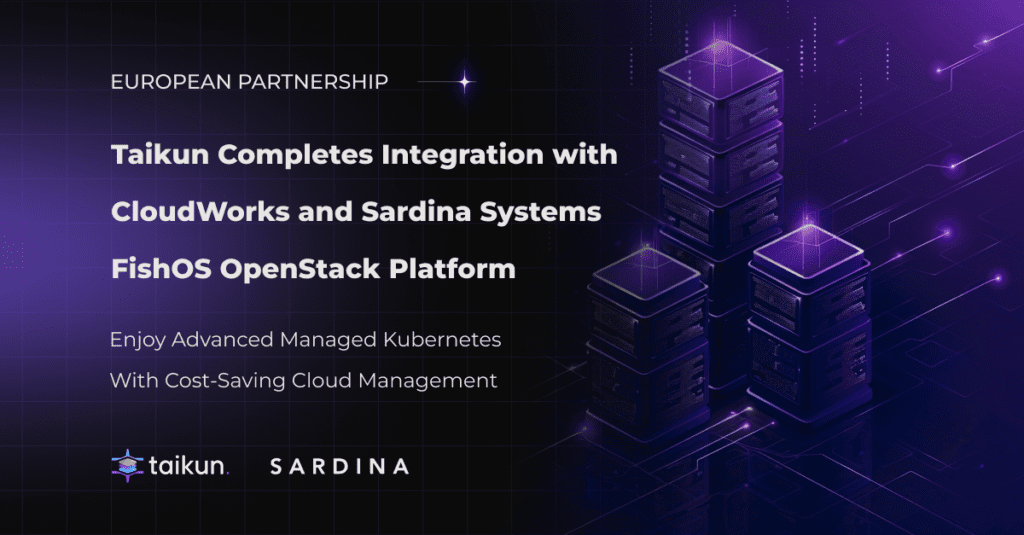The CrowdStrike Incident: A Global Wake-Up Call for Cloud Resilience


On July 19, 2024, the digital world experienced a seismic shock as a CrowdStrike software update for its software called Falcon Sensor, which scans a computer for intrusions and signs of hacking led to a global outage, affecting countless organizations worldwide. As a Principal Product Evangelist at Taikun, I believe this incident highlights the critical […]
Announcing Our Strategic Partnership with Sardina Systems


We’re thrilled to announce our strategic partnership with Sardina Systems, a leading provider of OpenStack cloud solutions. This collaboration brings together the best of both worlds – Taikun CloudWorks‘ advanced ‘Managed Kubernetes’ and application delivery platform, and Sardina Systems’ FishOS cloud management platform. At Taikun, we’re on a mission to make Kubernetes almost invisible to […]
Introducing Kubernetes Architecture – From Zero to Deployment


Kubernetes has been a game-changer in the growth of cloud adoption in the last decade. As more containerized applications take frontstage, Kubernetes has become the go-to container orchestration tool.
In this blog, we will go into the depths of Kubernetes and study its architecture. We will also see a simple workflow on how you can set up Kubernetes and deploy it on the cloud.
If you wish to read more about Kubernetes, you can start with our series on it from here. Let’s get started.
How Kubernetes Is Different From Docker Swarm?


Kubernetes and Docker Swarm are both very popular container orchestration tools in the industry. Every major cloud-native application uses a container orchestration tool of some sort. Kubernetes was developed by Google in the early 2010s from an internal project which managed billions of containers in the Google cloud infrastructure. You can read more about it in our blog here.
In this blog, we will go through the details of how Kubernetes and Docker Swarm differ from each other and how to choose the right tool for you.
What is Kubernetes and Why is it the Future of Cloud Computing


As more and more applications became cloud-native, containers became the ubiquitous way to bring flexibility and scalability to the system. As applications gained more and more functionality, it became essential to have an automated system for container management.
A system that creates, manages, and destroys containers as the traffic requirements change. This is called Container Orchestration. Kubernetes is the leading container orchestration tool in the cloud infrastructure today. It gives a level of abstraction over containers on a cloud infrastructure and groups them into logical units for easier management and discovery.
The Ultimate Guide to Getting Started With Kubernetes [2024 Updated]


According to a 2021 CNCF survey, 96% of all companies surveyed are either using or evaluating Kubernetes in their infrastructure. As you get comfortable using containers for your software deployment (read more about containers in our ultimate guide), you will soon require a tool to manage container deployments and configuration dynamically. This is where Kubernetes comes into the picture. Kubernetes is one of the most popular container orchestration tools. As the CTO for CNCF says, Kubernetes has now become utterly…
The Difference between Containers and Virtual Machines


The virtualization world has seen a sea change in the last 10 years. For a long time, Virtual Machines ruled the virtualization world. But ever since Docker Engine was launched in 2013, containers have become the go-to virtualization method for developers. Over time, the software development process has now shifted from a blame game of “it-works-on-my-machine” to smooth deployment of software systems performed 1000s of times every day.
What are containers? The definitive definition and the most common use cases


Containers are self-sufficient software packages that can run the service being agnostic to the underlying environment. It would contain everything from binaries to dependent libraries to configuration files. This makes containers easy to port. Since containers do not have operating system images, they are lightweight compared to Virtual Machines.
The Complete Guide on How To Get Started With Containers [2024 Updated]
![The_Complete_Guide_on_How_To_Get_Started_With_Containers_[2022_Updated]](https://b3662572.smushcdn.com/3662572/wp-content/uploads/2022/09/The_Complete_Guide_on_How_To_Get_Started_With_Containers_2022_Updated.png?lossy=2&strip=1&webp=1)
![The_Complete_Guide_on_How_To_Get_Started_With_Containers_[2022_Updated]](https://b3662572.smushcdn.com/3662572/wp-content/uploads/2022/09/The_Complete_Guide_on_How_To_Get_Started_With_Containers_2022_Updated.png?lossy=2&strip=1&webp=1)
Containers have become near ubiquitous in today’s IT infrastructure. A 2020 survey showed 89% of companies agreeing that Containers will play a strategic role for them in the near future. This pace has only increased with the Covid-19 pandemic. By 2022, many more companies have adopted cloud technologies and containerization as their key strategic play.


